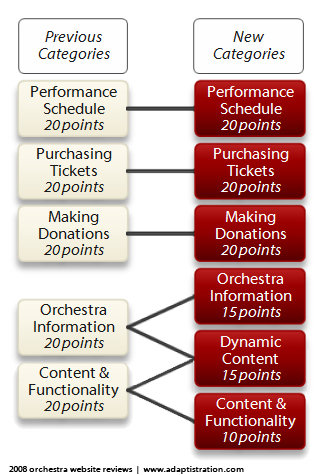Now in its fifth year, The Orchestra Website Review generates a great deal of interest regarding how orchestras of vastly different budget size can be compared on an even playing field. Happily, the answer is very straightforward…

In order to adequately examine an orchestra website it is useful to define the factors which contribute to an effective offering. At the core of every good orchestra website is the ability to generate revenue and create awareness which is accomplished through six distinct channels, each containing well defined quantifiable elements. When orchestra websites are examined from this perspective it becomes a straightforward process to identify the key elements for each section; as such, whether or not an orchestra has a budget that accommodates professional graphic design and employ full-time website specialists capable of creating an aesthetic web signature isn’t as important as designing a website that allows users to easily absorb crucial information and bolster the core goals.
As a result, these websites were not examined on the subjective basis of color schemes, layout, graphics, or other aesthetic qualities so long as those issues did not have a negative impact on basic functionality and site performance. By conducting the reviews under these conditions, evaluations are not only fair but orchestras of varying budget size can be evaluated on an even playing field.
Evaluation Criteria: New and Improved for 2008
The internet has changed quite a bit since the inaugural review back in 2004. These innovations have been refined to such a point that the fundamental shift in website design has been assigned a name: Web 2.0 standards. Wikipedia defines Web 2.0 as:
“…changing trends in the use of World Wide Web technology and web design that aims to enhance creativity, secure information sharing, collaboration and functionality of the web. Web 2.0 concepts have led to the development and evolution of web-based communities and its hosted services, such as social-networking sites, video sharing sites, wikis, [and] blogs…”
Web 2.0 standards are defined in even more detail by Andrew P. McAfee, associate professor with the Technology and Operations Management Unit at Harvard Business School, who coined the acronym SLATES to describe some typical features for Web 2.0 standards (which he defines as “Enterprise 2.0” standards) :
- Search: the ease of finding information through keyword search which makes the platform valuable.
- Links: guides to important pieces of information. The best pages are the most frequently linked to.
- Authoring: the ability to create constantly updating content over a platform that is shifted from being the creation of a few to being the constantly updated, interlinked work. In wikis, the content is iterative in the sense that the people undo and redo each other’s work. While in blogs is cumulative that posts and comments of individuals are accumulated over time.
- Tags: categorization of content by creating tags that are simple, one-word descriptions to facilitate searching and avoid rigid, pre-made categories.
- Extensions: automation some of the work and pattern matching by using algorithms e.g. amazon.com recommendations.
- Signals: the use of RSS (Really Simple Syndication) technology to notify users with any changes of the content by sending e-mails to them.
Consequently, all of these points have been incorporated into the 2008 Orchestra Website Review to one degree or another and closely follow the recommendations outlined in the How To Connect With New Media guide created for NPAC 2008 (available as a free eBook). In particular, the review categories have expanded from five to six in order to accommodate and properly weight each new and/or revised component. This migration is illustrated in the following figure:

Category 1: Performance Schedule – 20 points maximum
- Patrons need to be able to log onto an orchestra’s website and be able to gather information about the latest performances as well as upcoming events directly from the home page.
- This category contains two sub-categories which covered layout & organization features as well as monthly concert schedule displayed in a calendar-style navigation.
Category 2: Purchasing Tickets – 20 points maximum
- In addition to being able to find concert information quickly, patrons also need to be able to securely complete a ticket purchase for any given performance in no more than five minutes.
- This category contains five sub-categories covering features such as single ticket and subscription sales, ability to select seating, box office information, and secure purchasing options.
Category 3: Making Donations – 20 points maximum
- There isn’t a professional orchestra in the U.S. that doesn’t need donations. As such, encouraging patrons to donate online to a variety of programs is a crucial component for every orchestra website.
- This category contains two sub-categories addressing issues such as providing secure commerce servers and a variety of one time and preplanned giving options.
Category 4: Orchestra Information – 15 points maximum
- Learning about an orchestra and having easy access to contact information and educational program information is crucial to an orchestra’s ability to establish meaningful connections with its community.
- This category contains five sub-categories covering biographical and contact information for music directors and musicians. Staff and board listings with related individual contact info were also considered essential as well as providing copies of institutional transparency documents.
Category 5: Dynamic Content – 15 points maximum
- This category contains the bulk of new evaluation criteria and incorporates the bulk of material defined by the SLATES criteria.
- This category contains five subcategories including educational offerings, traditional media content, and PR contact information from previous reviews as well as introducing sub-categories measuring how well each website utilizes extensions, signals, and authoring tools.
Category 6: Content & Functionality – 10 points maximum
- If patrons can’t find your website then it won’t really matter how nice of a site you develop. Orchestras need to be able to present large amounts of information and e-commerce solutions to their patrons without overloading them or making it difficult to find what they need. Accuracy, current information, uniqueness of offerings, and providing institutional transparency documents all play an important role in this category.
- This category contains five sub-categories covering issues such as URL clarity, navigation structure, “searchability,” site performance, and legal notices.
Who’s In, Who’s Out
New for 2008 review is the addition of the Huntsville Symphony but orchestras no longer meeting the minimum evaluation criteria are Akron Symphony, Canton Symphony, Erie Philharmonic, Shreveport Symphony, and South Bend Symphony. Review data for the latter group is still available in the print edition of The Orchestra Website Review.


